System Management: OS Commands and Android Operating System Analysis
VerifiedAdded on 2020/02/24
|11
|1890
|309
Homework Assignment
AI Summary
This homework assignment delves into system management, focusing on command-line utilities in both Linux and Windows operating systems. The first part of the assignment examines specific commands like `ifconfig`, `ping`, `nslookup`, and `arp`, detailing their purposes and functionalities through examples. The second part provides an overview of the Android operating system, including its architecture, which is based on the Linux kernel, and its runtime environment, the Dalvik Virtual Machine. The assignment further explores the advantages and disadvantages of the Android OS, discussing technical details such as different versions, API levels, and market distribution. Furthermore, it provides a conclusion summarizing the key aspects of the Android operating system and its open-source nature.
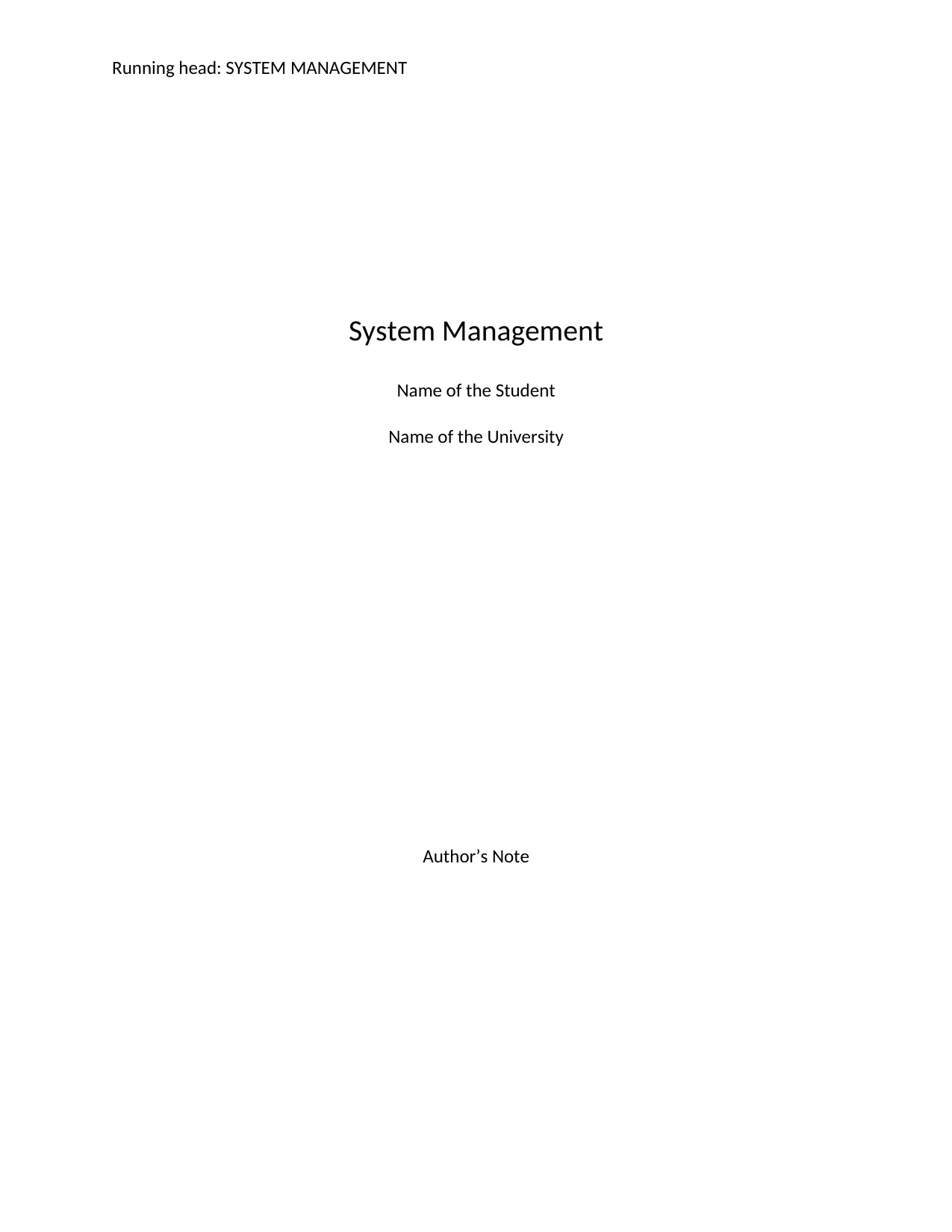
Running head: SYSTEM MANAGEMENT
System Management
Name of the Student
Name of the University
Author’s Note
System Management
Name of the Student
Name of the University
Author’s Note
Paraphrase This Document
Need a fresh take? Get an instant paraphrase of this document with our AI Paraphraser
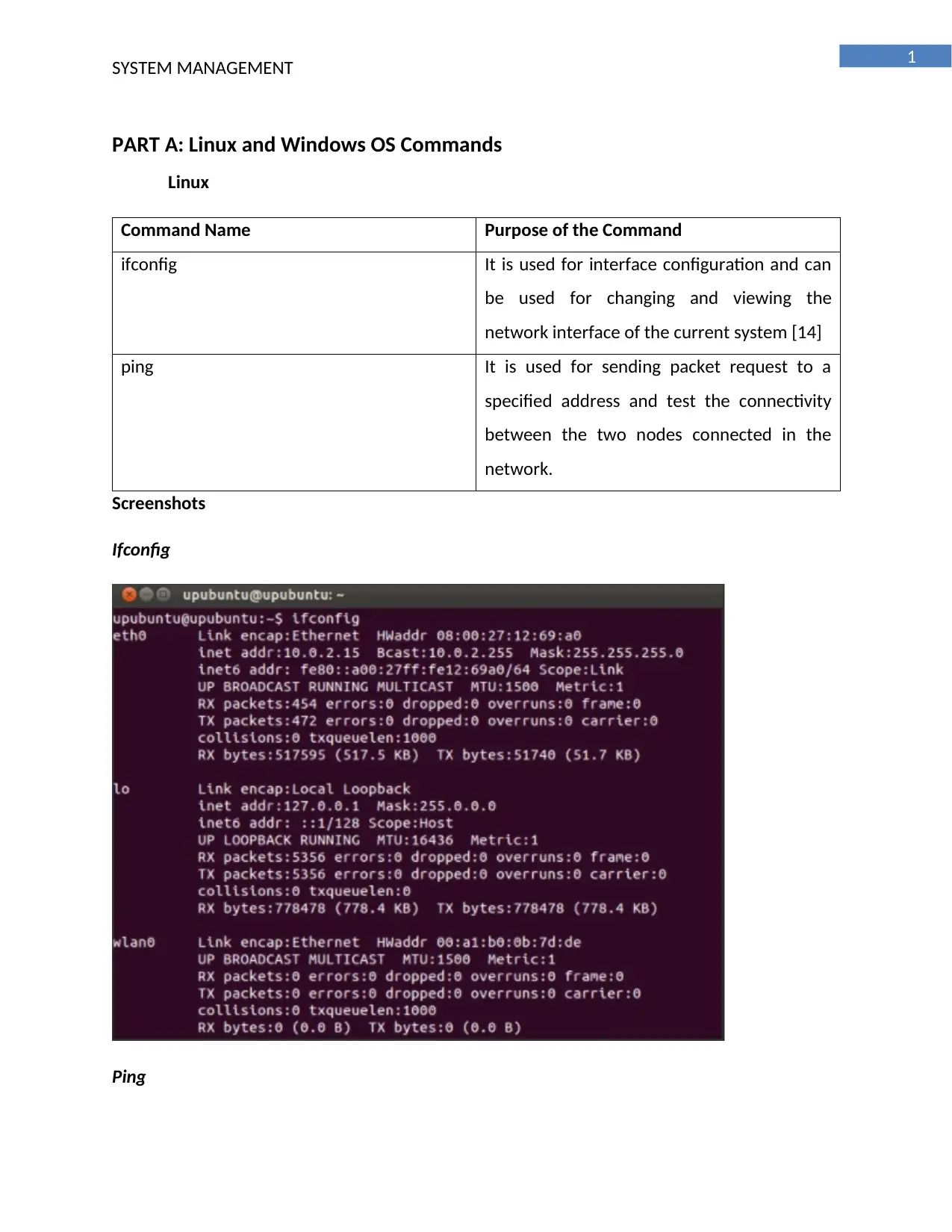
1
SYSTEM MANAGEMENT
PART A: Linux and Windows OS Commands
Linux
Command Name Purpose of the Command
ifconfig It is used for interface configuration and can
be used for changing and viewing the
network interface of the current system [14]
ping It is used for sending packet request to a
specified address and test the connectivity
between the two nodes connected in the
network.
Screenshots
Ifconfig
Ping
SYSTEM MANAGEMENT
PART A: Linux and Windows OS Commands
Linux
Command Name Purpose of the Command
ifconfig It is used for interface configuration and can
be used for changing and viewing the
network interface of the current system [14]
ping It is used for sending packet request to a
specified address and test the connectivity
between the two nodes connected in the
network.
Screenshots
Ifconfig
Ping
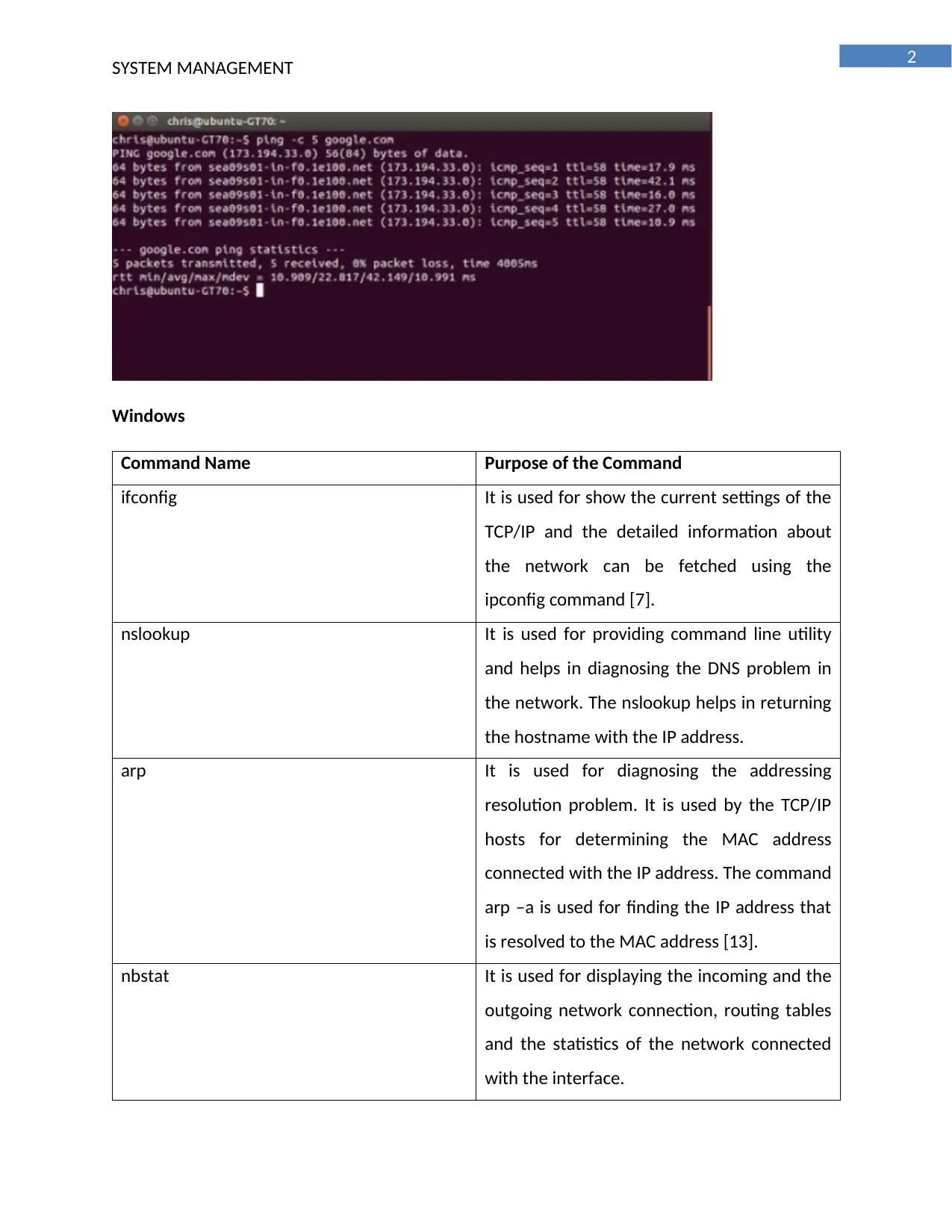
2
SYSTEM MANAGEMENT
Windows
Command Name Purpose of the Command
ifconfig It is used for show the current settings of the
TCP/IP and the detailed information about
the network can be fetched using the
ipconfig command [7].
nslookup It is used for providing command line utility
and helps in diagnosing the DNS problem in
the network. The nslookup helps in returning
the hostname with the IP address.
arp It is used for diagnosing the addressing
resolution problem. It is used by the TCP/IP
hosts for determining the MAC address
connected with the IP address. The command
arp –a is used for finding the IP address that
is resolved to the MAC address [13].
nbstat It is used for displaying the incoming and the
outgoing network connection, routing tables
and the statistics of the network connected
with the interface.
SYSTEM MANAGEMENT
Windows
Command Name Purpose of the Command
ifconfig It is used for show the current settings of the
TCP/IP and the detailed information about
the network can be fetched using the
ipconfig command [7].
nslookup It is used for providing command line utility
and helps in diagnosing the DNS problem in
the network. The nslookup helps in returning
the hostname with the IP address.
arp It is used for diagnosing the addressing
resolution problem. It is used by the TCP/IP
hosts for determining the MAC address
connected with the IP address. The command
arp –a is used for finding the IP address that
is resolved to the MAC address [13].
nbstat It is used for displaying the incoming and the
outgoing network connection, routing tables
and the statistics of the network connected
with the interface.
⊘ This is a preview!⊘
Do you want full access?
Subscribe today to unlock all pages.

Trusted by 1+ million students worldwide
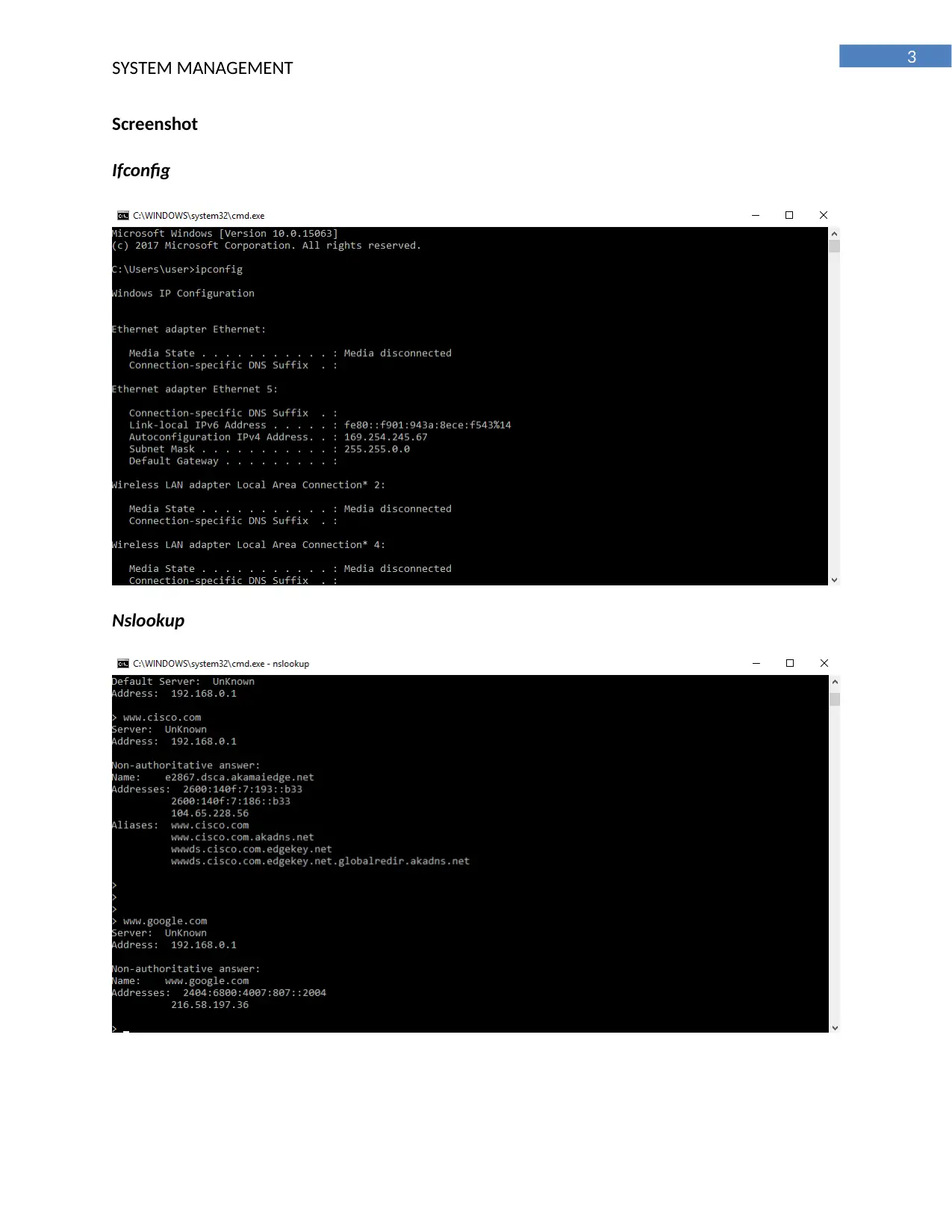
3
SYSTEM MANAGEMENT
Screenshot
Ifconfig
Nslookup
SYSTEM MANAGEMENT
Screenshot
Ifconfig
Nslookup
Paraphrase This Document
Need a fresh take? Get an instant paraphrase of this document with our AI Paraphraser
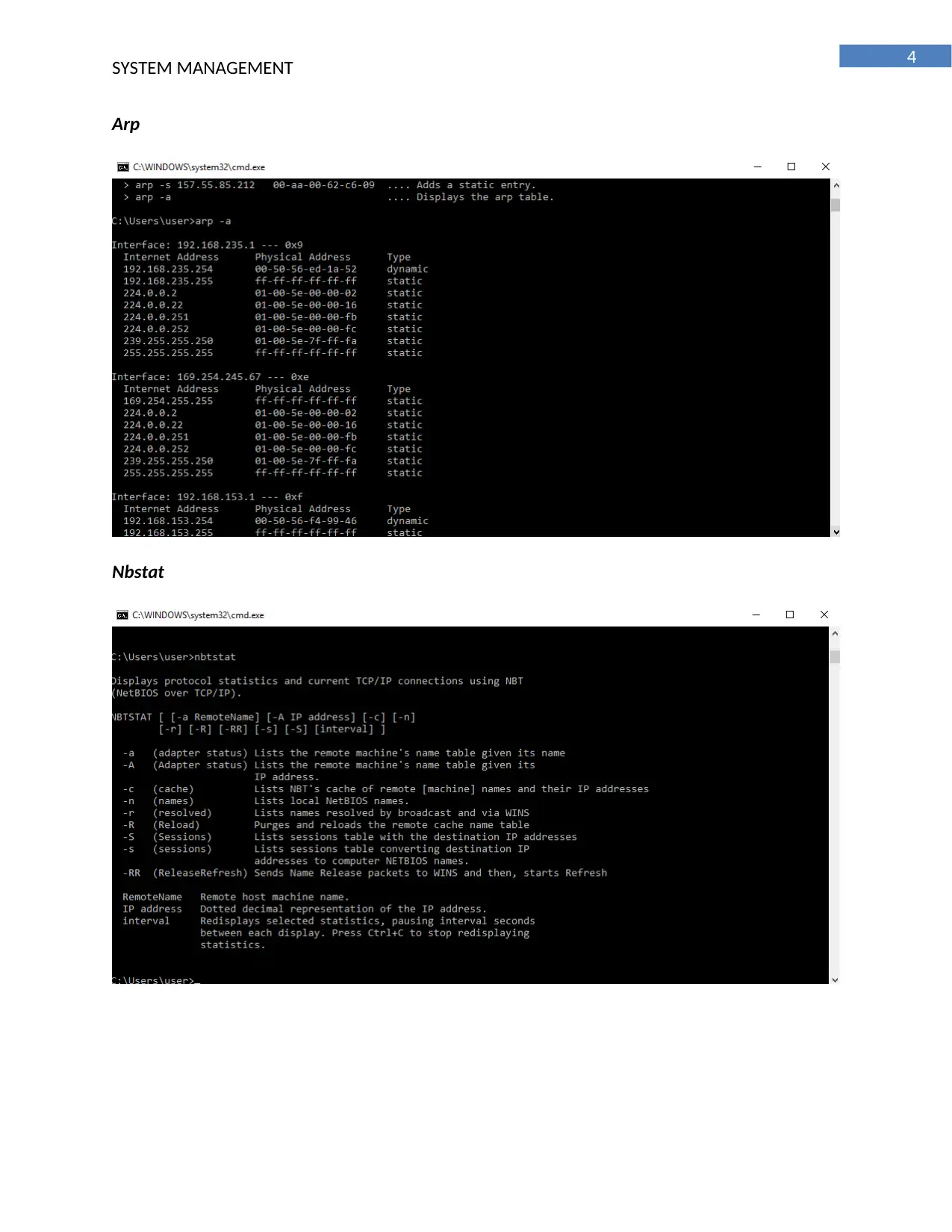
4
SYSTEM MANAGEMENT
Arp
Nbstat
SYSTEM MANAGEMENT
Arp
Nbstat
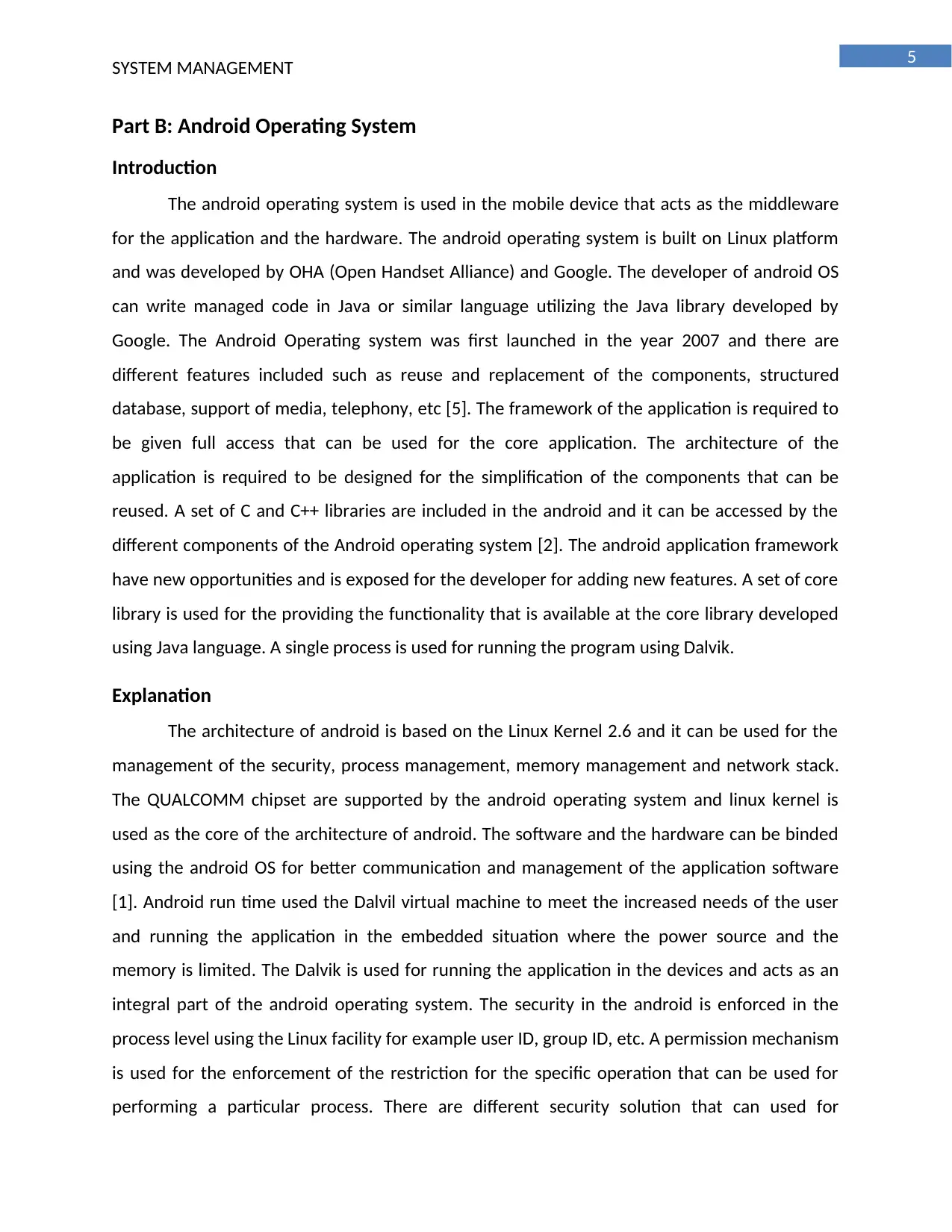
5
SYSTEM MANAGEMENT
Part B: Android Operating System
Introduction
The android operating system is used in the mobile device that acts as the middleware
for the application and the hardware. The android operating system is built on Linux platform
and was developed by OHA (Open Handset Alliance) and Google. The developer of android OS
can write managed code in Java or similar language utilizing the Java library developed by
Google. The Android Operating system was first launched in the year 2007 and there are
different features included such as reuse and replacement of the components, structured
database, support of media, telephony, etc [5]. The framework of the application is required to
be given full access that can be used for the core application. The architecture of the
application is required to be designed for the simplification of the components that can be
reused. A set of C and C++ libraries are included in the android and it can be accessed by the
different components of the Android operating system [2]. The android application framework
have new opportunities and is exposed for the developer for adding new features. A set of core
library is used for the providing the functionality that is available at the core library developed
using Java language. A single process is used for running the program using Dalvik.
Explanation
The architecture of android is based on the Linux Kernel 2.6 and it can be used for the
management of the security, process management, memory management and network stack.
The QUALCOMM chipset are supported by the android operating system and linux kernel is
used as the core of the architecture of android. The software and the hardware can be binded
using the android OS for better communication and management of the application software
[1]. Android run time used the Dalvil virtual machine to meet the increased needs of the user
and running the application in the embedded situation where the power source and the
memory is limited. The Dalvik is used for running the application in the devices and acts as an
integral part of the android operating system. The security in the android is enforced in the
process level using the Linux facility for example user ID, group ID, etc. A permission mechanism
is used for the enforcement of the restriction for the specific operation that can be used for
performing a particular process. There are different security solution that can used for
SYSTEM MANAGEMENT
Part B: Android Operating System
Introduction
The android operating system is used in the mobile device that acts as the middleware
for the application and the hardware. The android operating system is built on Linux platform
and was developed by OHA (Open Handset Alliance) and Google. The developer of android OS
can write managed code in Java or similar language utilizing the Java library developed by
Google. The Android Operating system was first launched in the year 2007 and there are
different features included such as reuse and replacement of the components, structured
database, support of media, telephony, etc [5]. The framework of the application is required to
be given full access that can be used for the core application. The architecture of the
application is required to be designed for the simplification of the components that can be
reused. A set of C and C++ libraries are included in the android and it can be accessed by the
different components of the Android operating system [2]. The android application framework
have new opportunities and is exposed for the developer for adding new features. A set of core
library is used for the providing the functionality that is available at the core library developed
using Java language. A single process is used for running the program using Dalvik.
Explanation
The architecture of android is based on the Linux Kernel 2.6 and it can be used for the
management of the security, process management, memory management and network stack.
The QUALCOMM chipset are supported by the android operating system and linux kernel is
used as the core of the architecture of android. The software and the hardware can be binded
using the android OS for better communication and management of the application software
[1]. Android run time used the Dalvil virtual machine to meet the increased needs of the user
and running the application in the embedded situation where the power source and the
memory is limited. The Dalvik is used for running the application in the devices and acts as an
integral part of the android operating system. The security in the android is enforced in the
process level using the Linux facility for example user ID, group ID, etc. A permission mechanism
is used for the enforcement of the restriction for the specific operation that can be used for
performing a particular process. There are different security solution that can used for
⊘ This is a preview!⊘
Do you want full access?
Subscribe today to unlock all pages.

Trusted by 1+ million students worldwide
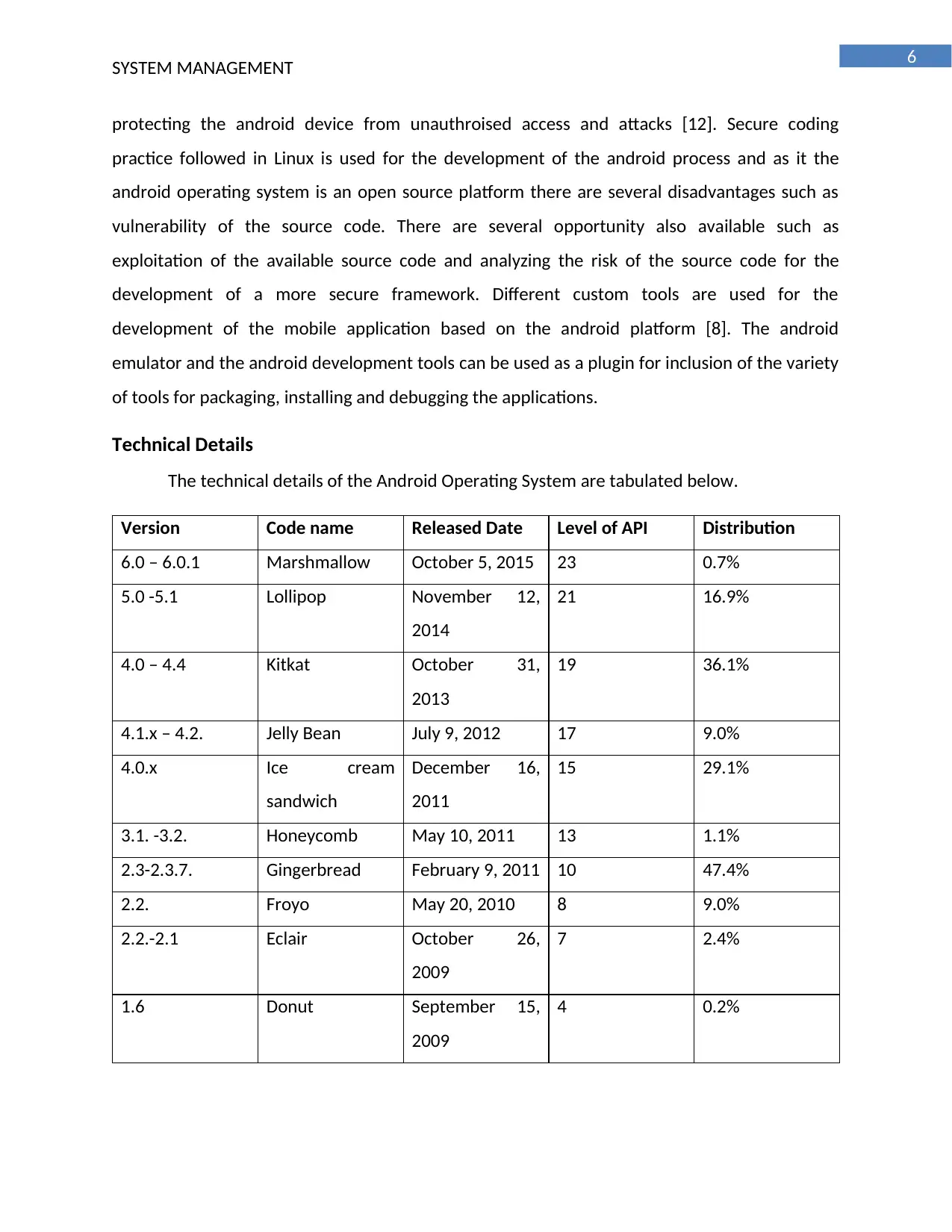
6
SYSTEM MANAGEMENT
protecting the android device from unauthroised access and attacks [12]. Secure coding
practice followed in Linux is used for the development of the android process and as it the
android operating system is an open source platform there are several disadvantages such as
vulnerability of the source code. There are several opportunity also available such as
exploitation of the available source code and analyzing the risk of the source code for the
development of a more secure framework. Different custom tools are used for the
development of the mobile application based on the android platform [8]. The android
emulator and the android development tools can be used as a plugin for inclusion of the variety
of tools for packaging, installing and debugging the applications.
Technical Details
The technical details of the Android Operating System are tabulated below.
Version Code name Released Date Level of API Distribution
6.0 – 6.0.1 Marshmallow October 5, 2015 23 0.7%
5.0 -5.1 Lollipop November 12,
2014
21 16.9%
4.0 – 4.4 Kitkat October 31,
2013
19 36.1%
4.1.x – 4.2. Jelly Bean July 9, 2012 17 9.0%
4.0.x Ice cream
sandwich
December 16,
2011
15 29.1%
3.1. -3.2. Honeycomb May 10, 2011 13 1.1%
2.3-2.3.7. Gingerbread February 9, 2011 10 47.4%
2.2. Froyo May 20, 2010 8 9.0%
2.2.-2.1 Eclair October 26,
2009
7 2.4%
1.6 Donut September 15,
2009
4 0.2%
SYSTEM MANAGEMENT
protecting the android device from unauthroised access and attacks [12]. Secure coding
practice followed in Linux is used for the development of the android process and as it the
android operating system is an open source platform there are several disadvantages such as
vulnerability of the source code. There are several opportunity also available such as
exploitation of the available source code and analyzing the risk of the source code for the
development of a more secure framework. Different custom tools are used for the
development of the mobile application based on the android platform [8]. The android
emulator and the android development tools can be used as a plugin for inclusion of the variety
of tools for packaging, installing and debugging the applications.
Technical Details
The technical details of the Android Operating System are tabulated below.
Version Code name Released Date Level of API Distribution
6.0 – 6.0.1 Marshmallow October 5, 2015 23 0.7%
5.0 -5.1 Lollipop November 12,
2014
21 16.9%
4.0 – 4.4 Kitkat October 31,
2013
19 36.1%
4.1.x – 4.2. Jelly Bean July 9, 2012 17 9.0%
4.0.x Ice cream
sandwich
December 16,
2011
15 29.1%
3.1. -3.2. Honeycomb May 10, 2011 13 1.1%
2.3-2.3.7. Gingerbread February 9, 2011 10 47.4%
2.2. Froyo May 20, 2010 8 9.0%
2.2.-2.1 Eclair October 26,
2009
7 2.4%
1.6 Donut September 15,
2009
4 0.2%
Paraphrase This Document
Need a fresh take? Get an instant paraphrase of this document with our AI Paraphraser
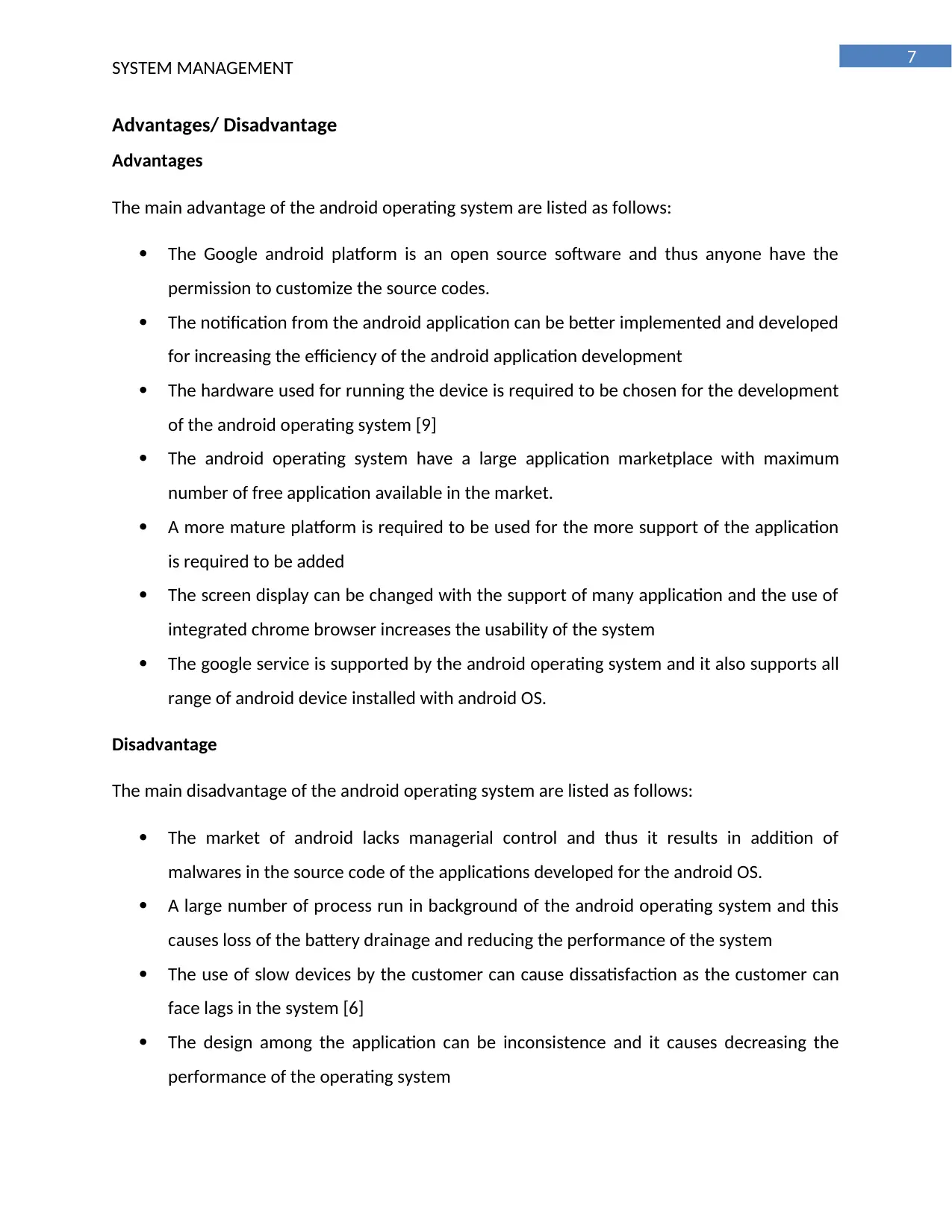
7
SYSTEM MANAGEMENT
Advantages/ Disadvantage
Advantages
The main advantage of the android operating system are listed as follows:
The Google android platform is an open source software and thus anyone have the
permission to customize the source codes.
The notification from the android application can be better implemented and developed
for increasing the efficiency of the android application development
The hardware used for running the device is required to be chosen for the development
of the android operating system [9]
The android operating system have a large application marketplace with maximum
number of free application available in the market.
A more mature platform is required to be used for the more support of the application
is required to be added
The screen display can be changed with the support of many application and the use of
integrated chrome browser increases the usability of the system
The google service is supported by the android operating system and it also supports all
range of android device installed with android OS.
Disadvantage
The main disadvantage of the android operating system are listed as follows:
The market of android lacks managerial control and thus it results in addition of
malwares in the source code of the applications developed for the android OS.
A large number of process run in background of the android operating system and this
causes loss of the battery drainage and reducing the performance of the system
The use of slow devices by the customer can cause dissatisfaction as the customer can
face lags in the system [6]
The design among the application can be inconsistence and it causes decreasing the
performance of the operating system
SYSTEM MANAGEMENT
Advantages/ Disadvantage
Advantages
The main advantage of the android operating system are listed as follows:
The Google android platform is an open source software and thus anyone have the
permission to customize the source codes.
The notification from the android application can be better implemented and developed
for increasing the efficiency of the android application development
The hardware used for running the device is required to be chosen for the development
of the android operating system [9]
The android operating system have a large application marketplace with maximum
number of free application available in the market.
A more mature platform is required to be used for the more support of the application
is required to be added
The screen display can be changed with the support of many application and the use of
integrated chrome browser increases the usability of the system
The google service is supported by the android operating system and it also supports all
range of android device installed with android OS.
Disadvantage
The main disadvantage of the android operating system are listed as follows:
The market of android lacks managerial control and thus it results in addition of
malwares in the source code of the applications developed for the android OS.
A large number of process run in background of the android operating system and this
causes loss of the battery drainage and reducing the performance of the system
The use of slow devices by the customer can cause dissatisfaction as the customer can
face lags in the system [6]
The design among the application can be inconsistence and it causes decreasing the
performance of the operating system
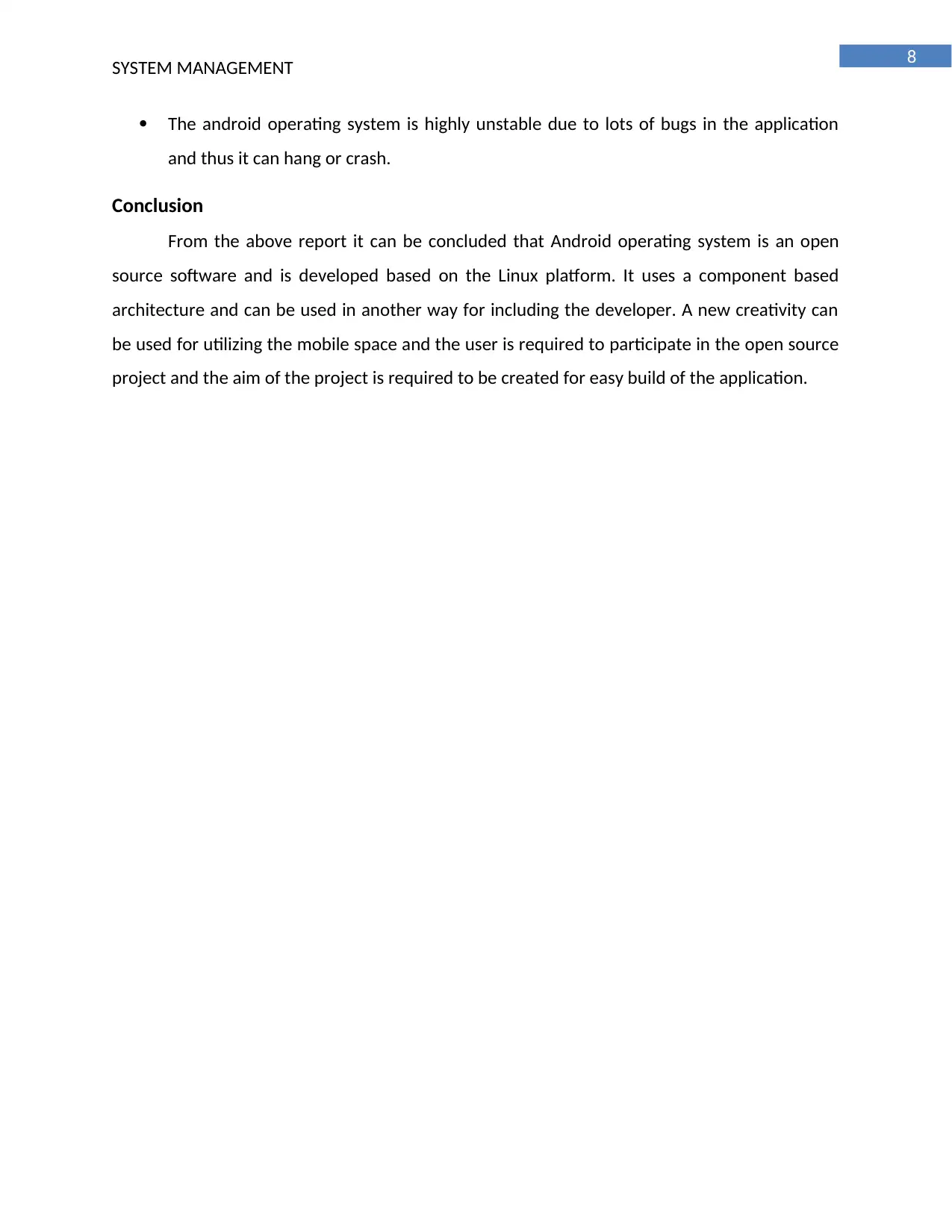
8
SYSTEM MANAGEMENT
The android operating system is highly unstable due to lots of bugs in the application
and thus it can hang or crash.
Conclusion
From the above report it can be concluded that Android operating system is an open
source software and is developed based on the Linux platform. It uses a component based
architecture and can be used in another way for including the developer. A new creativity can
be used for utilizing the mobile space and the user is required to participate in the open source
project and the aim of the project is required to be created for easy build of the application.
SYSTEM MANAGEMENT
The android operating system is highly unstable due to lots of bugs in the application
and thus it can hang or crash.
Conclusion
From the above report it can be concluded that Android operating system is an open
source software and is developed based on the Linux platform. It uses a component based
architecture and can be used in another way for including the developer. A new creativity can
be used for utilizing the mobile space and the user is required to participate in the open source
project and the aim of the project is required to be created for easy build of the application.
⊘ This is a preview!⊘
Do you want full access?
Subscribe today to unlock all pages.

Trusted by 1+ million students worldwide
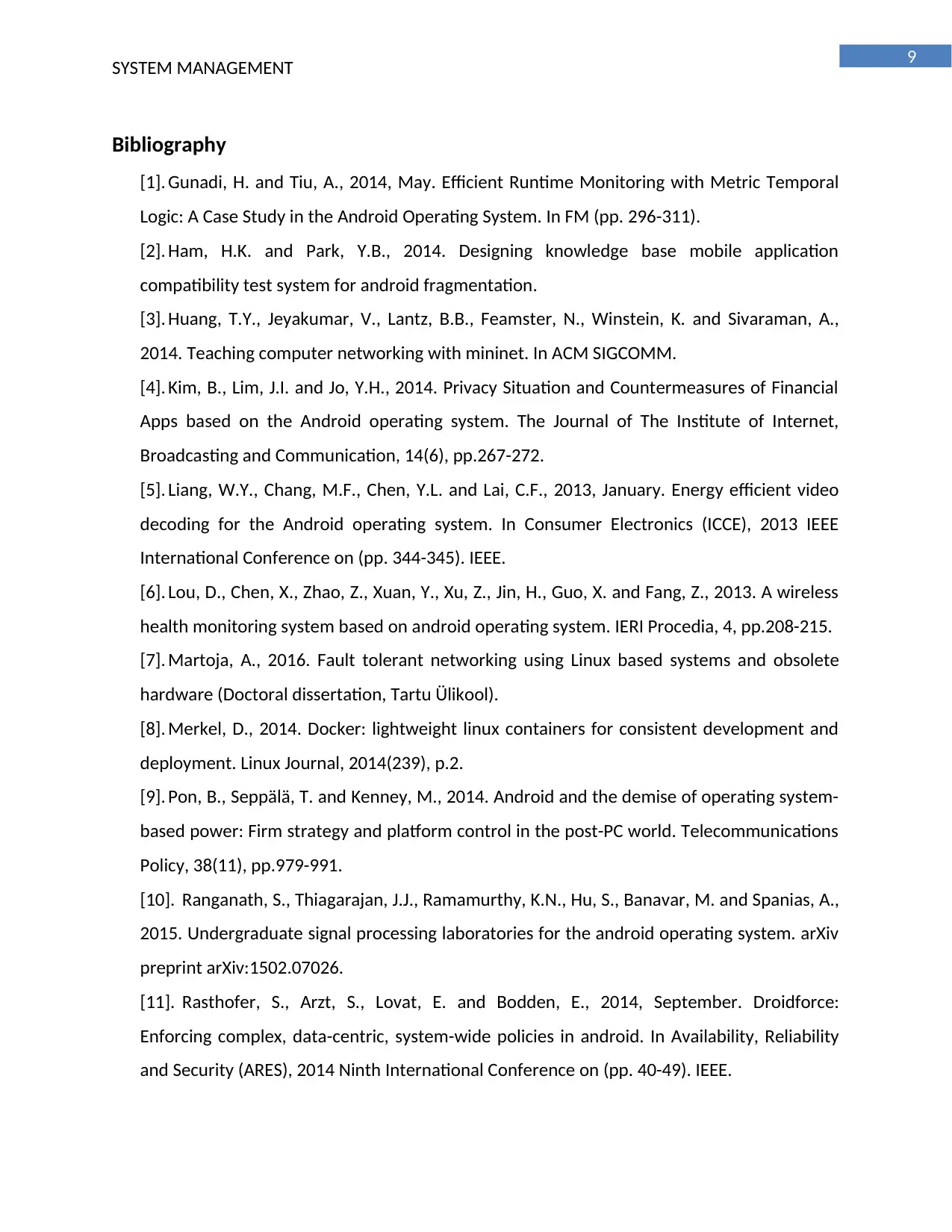
9
SYSTEM MANAGEMENT
Bibliography
[1]. Gunadi, H. and Tiu, A., 2014, May. Efficient Runtime Monitoring with Metric Temporal
Logic: A Case Study in the Android Operating System. In FM (pp. 296-311).
[2]. Ham, H.K. and Park, Y.B., 2014. Designing knowledge base mobile application
compatibility test system for android fragmentation.
[3]. Huang, T.Y., Jeyakumar, V., Lantz, B.B., Feamster, N., Winstein, K. and Sivaraman, A.,
2014. Teaching computer networking with mininet. In ACM SIGCOMM.
[4]. Kim, B., Lim, J.I. and Jo, Y.H., 2014. Privacy Situation and Countermeasures of Financial
Apps based on the Android operating system. The Journal of The Institute of Internet,
Broadcasting and Communication, 14(6), pp.267-272.
[5]. Liang, W.Y., Chang, M.F., Chen, Y.L. and Lai, C.F., 2013, January. Energy efficient video
decoding for the Android operating system. In Consumer Electronics (ICCE), 2013 IEEE
International Conference on (pp. 344-345). IEEE.
[6]. Lou, D., Chen, X., Zhao, Z., Xuan, Y., Xu, Z., Jin, H., Guo, X. and Fang, Z., 2013. A wireless
health monitoring system based on android operating system. IERI Procedia, 4, pp.208-215.
[7]. Martoja, A., 2016. Fault tolerant networking using Linux based systems and obsolete
hardware (Doctoral dissertation, Tartu Ülikool).
[8]. Merkel, D., 2014. Docker: lightweight linux containers for consistent development and
deployment. Linux Journal, 2014(239), p.2.
[9]. Pon, B., Seppälä, T. and Kenney, M., 2014. Android and the demise of operating system-
based power: Firm strategy and platform control in the post-PC world. Telecommunications
Policy, 38(11), pp.979-991.
[10]. Ranganath, S., Thiagarajan, J.J., Ramamurthy, K.N., Hu, S., Banavar, M. and Spanias, A.,
2015. Undergraduate signal processing laboratories for the android operating system. arXiv
preprint arXiv:1502.07026.
[11]. Rasthofer, S., Arzt, S., Lovat, E. and Bodden, E., 2014, September. Droidforce:
Enforcing complex, data-centric, system-wide policies in android. In Availability, Reliability
and Security (ARES), 2014 Ninth International Conference on (pp. 40-49). IEEE.
SYSTEM MANAGEMENT
Bibliography
[1]. Gunadi, H. and Tiu, A., 2014, May. Efficient Runtime Monitoring with Metric Temporal
Logic: A Case Study in the Android Operating System. In FM (pp. 296-311).
[2]. Ham, H.K. and Park, Y.B., 2014. Designing knowledge base mobile application
compatibility test system for android fragmentation.
[3]. Huang, T.Y., Jeyakumar, V., Lantz, B.B., Feamster, N., Winstein, K. and Sivaraman, A.,
2014. Teaching computer networking with mininet. In ACM SIGCOMM.
[4]. Kim, B., Lim, J.I. and Jo, Y.H., 2014. Privacy Situation and Countermeasures of Financial
Apps based on the Android operating system. The Journal of The Institute of Internet,
Broadcasting and Communication, 14(6), pp.267-272.
[5]. Liang, W.Y., Chang, M.F., Chen, Y.L. and Lai, C.F., 2013, January. Energy efficient video
decoding for the Android operating system. In Consumer Electronics (ICCE), 2013 IEEE
International Conference on (pp. 344-345). IEEE.
[6]. Lou, D., Chen, X., Zhao, Z., Xuan, Y., Xu, Z., Jin, H., Guo, X. and Fang, Z., 2013. A wireless
health monitoring system based on android operating system. IERI Procedia, 4, pp.208-215.
[7]. Martoja, A., 2016. Fault tolerant networking using Linux based systems and obsolete
hardware (Doctoral dissertation, Tartu Ülikool).
[8]. Merkel, D., 2014. Docker: lightweight linux containers for consistent development and
deployment. Linux Journal, 2014(239), p.2.
[9]. Pon, B., Seppälä, T. and Kenney, M., 2014. Android and the demise of operating system-
based power: Firm strategy and platform control in the post-PC world. Telecommunications
Policy, 38(11), pp.979-991.
[10]. Ranganath, S., Thiagarajan, J.J., Ramamurthy, K.N., Hu, S., Banavar, M. and Spanias, A.,
2015. Undergraduate signal processing laboratories for the android operating system. arXiv
preprint arXiv:1502.07026.
[11]. Rasthofer, S., Arzt, S., Lovat, E. and Bodden, E., 2014, September. Droidforce:
Enforcing complex, data-centric, system-wide policies in android. In Availability, Reliability
and Security (ARES), 2014 Ninth International Conference on (pp. 40-49). IEEE.
Paraphrase This Document
Need a fresh take? Get an instant paraphrase of this document with our AI Paraphraser
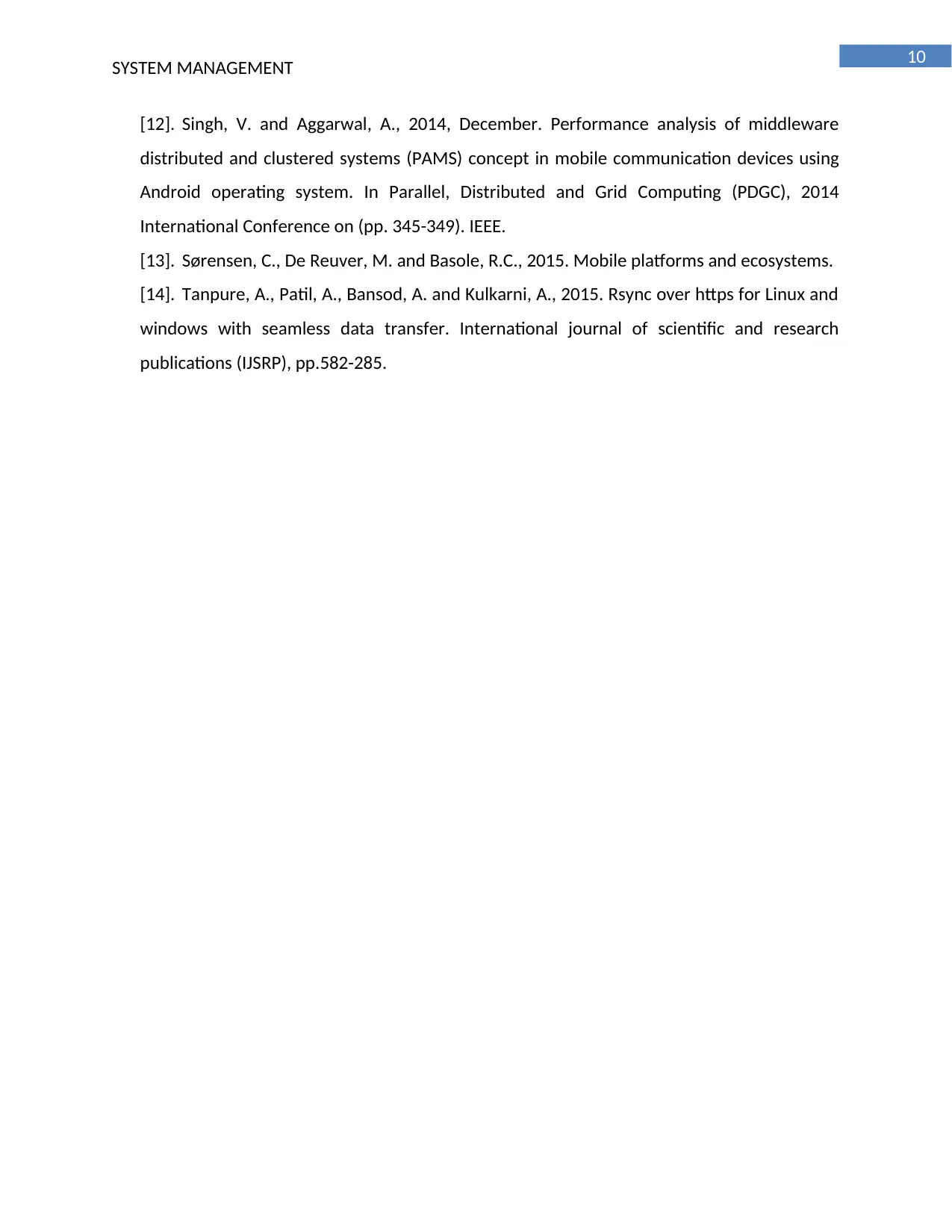
10
SYSTEM MANAGEMENT
[12]. Singh, V. and Aggarwal, A., 2014, December. Performance analysis of middleware
distributed and clustered systems (PAMS) concept in mobile communication devices using
Android operating system. In Parallel, Distributed and Grid Computing (PDGC), 2014
International Conference on (pp. 345-349). IEEE.
[13]. Sørensen, C., De Reuver, M. and Basole, R.C., 2015. Mobile platforms and ecosystems.
[14]. Tanpure, A., Patil, A., Bansod, A. and Kulkarni, A., 2015. Rsync over https for Linux and
windows with seamless data transfer. International journal of scientific and research
publications (IJSRP), pp.582-285.
SYSTEM MANAGEMENT
[12]. Singh, V. and Aggarwal, A., 2014, December. Performance analysis of middleware
distributed and clustered systems (PAMS) concept in mobile communication devices using
Android operating system. In Parallel, Distributed and Grid Computing (PDGC), 2014
International Conference on (pp. 345-349). IEEE.
[13]. Sørensen, C., De Reuver, M. and Basole, R.C., 2015. Mobile platforms and ecosystems.
[14]. Tanpure, A., Patil, A., Bansod, A. and Kulkarni, A., 2015. Rsync over https for Linux and
windows with seamless data transfer. International journal of scientific and research
publications (IJSRP), pp.582-285.
1 out of 11
Related Documents
Your All-in-One AI-Powered Toolkit for Academic Success.
+13062052269
info@desklib.com
Available 24*7 on WhatsApp / Email
![[object Object]](/_next/static/media/star-bottom.7253800d.svg)
Unlock your academic potential
Copyright © 2020–2025 A2Z Services. All Rights Reserved. Developed and managed by ZUCOL.





